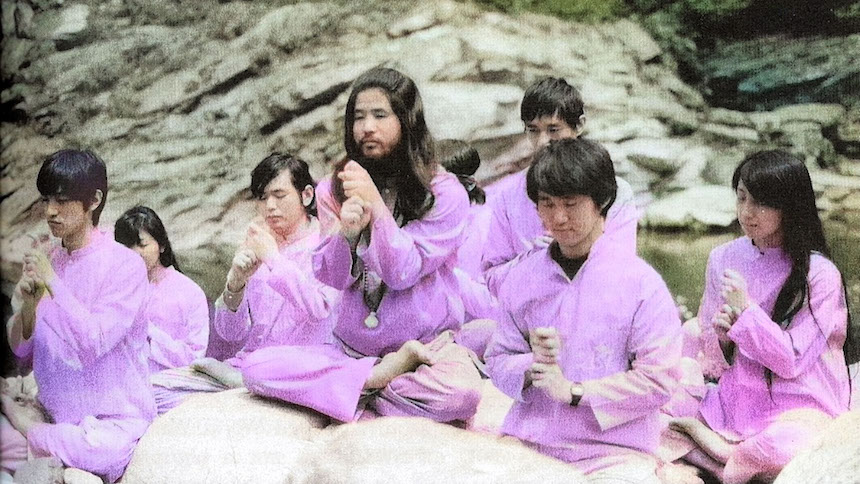Sundance 2023 Review: AUM: THE CULT AT THE END OF THE WORLD Offers Anatomy of Terror
Chiaki Yanagimoto and Ben Braun's documentary goes behind the scenes of the 1995 Sarin gas attack in a Tokyo subway.

True crime and cults are a match made in heaven for driving viewership. While the combination has persisted in documentary cinema for some time, Netflix´s Wild Wild Country reinvigorated the genre and the demand.
Sensationalism cannot be always avoided, as in the recent case of the NXIVM revelations. Newcomers Chiaki Yanagimoto and Ben Braun debuted at Sundance's U.S. Documentary Competition with AUM: The Cult at the End of the World, which relies less on the sensationalism of the matter and more on the investigative rigor and journalistic labor.
The documentary is based on the book The Cult at the End of the World: The Terrifying Story of the Aum Doomsday Cult, from the Subways of Tokyo to the Nuclear Arsenals of Russia, written by David E. Kaplan and Andrew Marshall.
Yanagimoto and Braun's film reveals how the notorious 1995 Sarin gas attack in a Tokyo subway happened to decompose the snowball effect of a single madman charming flocks of seekers for higher meaning. The mastermind behind the whole operation, Shoko Asahara, was executed in 2018 alongside other members of a terrorist group veiled as a spiritual movement, Aum Sinrikyo, which turned out to be a doomsday cult. Asahara charted his own career without necessarily reaching out for Jim Jones' playbook.
AUM: The Cult at the End of the World combines talking-head testimonies from journalists covering the suspicious spiritual group, former members, and parents of children who got lured into Asahara's clutches.
The filmmakers include period footage, framing the circumstances that enabled creation of such a deathly movement, and the reasons why the government hesitated to thwart it. The attention to socio-political and historic details makes AUM: The Cult at the End of the World a fascinating viewing in order to understand how microscopic events contributed to the compound effect.
A single chapter is dedicated to the guru tracing Asahara's business beginnings with an unlicensed pharmacy (being described as "a snake oil salesman") to pivoting to Yoga school as a better business model. From a slightly cynical perspective, the doomsday cult documentary is basically a feature-length case study on early solo-preneurship.
Market research, business model tinkering, finding the best product for mass market introduction, even the branding as an enlightened guru endowed with supernatural abilities, running PR stunts, and expanding the network to the West are on the checklist of a failed businessman, elevated teacher, populist politician, and a megalomanic sociopath turned indicted mass murderer.
The directors frame the historical moment in social, economic, and psychological contexts, explaining why overworked Japanese people were susceptible to being lured into a spiritual community. And then manipulated into heinous acts, which Asahara gradually escalated. The accelerated capitalism drove people into the search for higher knowledge and their pursuit of enlightenment drove them into the arms of the scheming guru with no scruples.
Asahara went from snake oil salesman to professional charmer, as his disciples were willing to overlook a series of red flags, including giving up their wealth and hygiene habits. The high-tech capitalistic era begged for another option in the realm of transcendental, and Asahara arrived with an offer too good to be turned down. Moreover, a paternal approach appeared to seal the deal, as many young adults came in droves to get what they were lacking at home.
AUM: The Cult at the End of the World does not follow a linear timeline. While the film ultimately maps the rise and fall of the cult and how the power-drunk leader succumbed to madness, Yanagimoto and Braun mix and match first-hand witness testimonials, introducing their personal narrative arcs within the history of AUM to provide insider insights and demonstrate a wider social collateral damage.
While the directors shy away from the gratuitous sensationalism the matter offers, they stick to the facts. Even moments of heightened emotional tension are handled with rationale. In essence, AUM: The Cult at the End of the World is an anatomy of manipulation, alienation, and isolation, and how it can all be harnessed in trying and polarizing times, all to the benefit of a single person.
As in previous instances of cults, AUM is ripe with stranger-than-fiction material. The fact that a supposed religious movement would have its own biochemical engineer is just a starting point that does not stop when weapons of mass destruction are acquired.
AUM: The Cult at the End of the World offers valuable awareness of how Asahara was able to rapidly expand his radius of unchallenged influence. He did this, not only over his followers, but also through public figures and media that sold him as a cherished public figure, despite fringe voices warning against him. Nobody batted an eye when he ran for public office or built his second base in Russia, returning with more weapons.
Yanagimoto and Braun's co-debut does not belong in the category of grab-them-by-the-eyeballs documentary fare pumped on cliffhangers. Instead of a glossy pop-stylized streamer documentary, AUM: The Cult at the End of the World is a rigorously laid-out anatomy of social disruption that was left untouched too long, causing a national tragedy. It feels like an adaptation of a book with several arcs running parallell and crisscrossing, inhabited by a bigger number of characters; viewers may get lost, with waning attention.
AUM: The Cult at the End of the World bears an eerie and present parable on radicalization in the atmosphere of discontent. The tactics stay the same, only the cast changes. And messianism wielded for profit and influence is a recipe for tragedy the same way the mingling of church and politics creates a highly toxic climate with the cost of lives.
The film screened at the 2023 Sundance Film Festival.
AUM: The Cult at the End of the World
Director(s)
- Ben Braun
- Chiaki Yanagimoto







